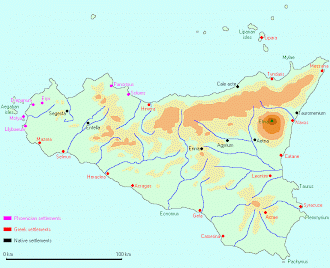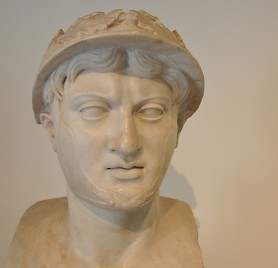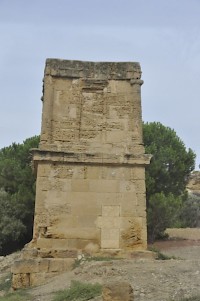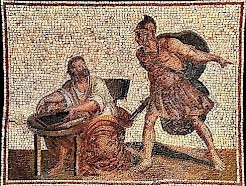Sicily (6)
Q1460Sicily: large and rich island opposite the Italian mainland. In Antiquity, it was settled by Phoenicians and Greeks, and contested by the Carthaginians, Romans, Ostrogoths, and Byzantines.
Third Century

Timoleon and Agathocles had made Syracuse into one of the strongest states in the Mediterranean, or so it seemed. If only they had been capable of overcoming the eternal divisions between oligarchs and democrats in their city, and creating some sort of panhellenic ideal on the island, the Greeks might have been able to maintain their independence. But the Greeks were, almost as if by nature, unable to cooperate - in the west and in their homeland. As it turned out, a divided Sicily could not survive when it found itself between the hammer and anvil of Carthage and Rome.
After the coup of Dion (above), the native nations of Sicily and Italy were no longer checked. Timoleon and Agathocles had been able to restore order on Sicily, but in Italy, the natives were definitely on the rise. Several once proudly independent Greek cities, had already been conquered long time ago, and the native people had started to imitate Greek political structures, built cities of their own, made military progress, and imitated Greek architecture. (On Sicily too: Segesta, for example, boasted a Greek-style temple.) The Italian nations now had much in common with the Greeks and it is easy to overestimate the cultural consequences of their successful wars against the Greek cities of southern Italy.
Yet, the Greeks had an understandable fear of their northern neighbors and had already invited king Archidamus III of Sparta, king Alexander of Molossis and Timoleon to defend them. Another problem was the rise of Rome, which had defeated its main opponents in the battle of Sentinum (295) and had entered the backyard of Tarentum when it founded a colonia at Venusia (291).
In 285, Thurii felt itself threatened by the native Lucanians. Agathocles was no longer alive -he had died in 288- and Syracuse could not protect the Greek city because it was at war with the Carthaginians, who were rapidly advancing to the east. Therefore, Thurii was forced to ask for help from Rome, which did what was demanded and gained valuable experience in the deep south. In 282, Thurii and Rhegium repeated the request. Again, Rome supported the Greek towns, but this time, it stationed garrisons in the cities. The Tarentines, who had always claimed the hegemony over the Greek towns in Italy, understood that they were losing status, and decided to strike at Rome before it was too late.

They received support from Pyrrhus of Epirus, a powerful warrior king who wanted to repeat in the west what Alexander the Great had done in the east, and a son-in-law of king Agathocles of Syracuse. Initially, he was successful and defeated the Romans twice, but the Roman diplomats replied with a treaty with Carthage. From now on, both sides would cooperate in a war against the Greek towns. This forced Pyrrhus to go to Sicily (278), where he was again very successful. Yet, his success became his undoing: his Sicilian allies wanted to remain independent and did not like becoming subjects of the Epirote king. They revolted, and Pyrrhus left Sicily to its own devices. In 276, he returned to Italy, where he was defeated by the Romans, who had in the meantime learned how to deal with Pyrrhus' elephants. Defeated on both fronts, the king returned to Greece, leaving Italy to Rome and Sicily as a cockpit for Rome and Carthage to fight in.note
When the Romans besieged Tarentum in 272, a Carthaginian navy appeared to support the Greeks. This was seen as a breach of the treaty and the alliance was canceled. A few years later, the Romans decided to declare war after an incident in Messana.
This town had been occupied by former Syracusan mercenaries, called the Mamertines. In 265, the tyrant of Syracuse, Hiero II, defeated them and laid siege to the city. Immediately, the Mamertines asked help from Carthage, which gladly intervened and sent its admiral Hannibal to defend and garrison Messana. From now on, the Carthaginians controlled the Strait. However, occupation was not the help the Mamertines had been hoping for. Rome received a call for help too, and decided to intervene, running the risk of full-scale Carthaginian intervention. But Rome could not ignore the request: from Messana, the Carthaginians threatened the Greek towns of southern Italy's, Rome's new allies. War was inevitable.

In 264, one of the Roman consuls, Appius Claudius Caudex, invaded Sicily with two legions and captured Messana: the First Punic War had broken out. The Carthaginians now allied itself to Syracuse -a most unusual action- and marched from their base at Acragas to Messana. Fighting was inconclusive, but Hiero of Syracuse witnessed the power of Rome, and allied himself to the invader (263). Next summer, the Romans laid siege to Acragas and captured the Carthaginian base (early 261), which had been defended by the same Hannibal who had garrisoned Messana. However, after these successes, the Roman war machine came to as standstill. The Carthaginians refused to accept Roman control of the Strait, and the Romans understood that they had to conquer the entire island. This meant that they had to gain naval superiority - something that would be very difficult, because the Romans were no sailors.note
It was a conflict between an elephant and a whale, which could go on forever. However, the Romans had a secret weapon, called corvus ("raven" or "crow"). This was a movable bridge with a metal prong that could be dropped onto the deck of a Carthaginian ship. Once the two ships were tied to each other, the naval battle had changed into a land battle. In other words, the Romans used their ships as platforms for fighting. In 260, at Mylae, their consul Gaius Duillius defeated admiral Hannibal, and won Rome's first naval victory ever.note
Yet, this victory was not decisive, and the war was to last very, very long. The Carthaginian commander Hamilcar was able to defend the western part of the island; and every Roman success was balanced by either a Carthaginian victory, Roman stupidity, or bad luck (e.g., the loss of a fleet in a storm). However, the Roman consul Gaius Atilius Regulus, having overcome the Carthaginian navy at Ecnomus, was able to repeat Agathocles' invasion of Africa, and although he was defeated by a Greek mercenary leader in Carthaginian service, Xanthippus, it was clear that Rome was the strongest of the two contenders. It had the resources to raise large armies and build new fleets. The final years of the war looked like a stalemate on western Sicily, where Hamilcar fought a guerilla war, but only the Romans was able to recuperate. In 241, a new Roman fleet, commanded by Gaius Lutatius Catulus, overcame the last Carthaginian ships, commanded by Hanno, near the Aegatian islands in the far west. A peace treaty was signed, and Carthage accepted Roman rule in Sicily. According to the Greek historian Polybius of Megalopolis, it had been "the longest and most severely contested war in history".note
From now on, Sicily was a province of Rome - the first one, and it is interesting to see how the Romans organized the island, because this became a model to the organization of new conquests. In the first place, the Roman system of alliances was not extended to Sicily. It would be useless to ask the Sicilians to send troops to, say, northern Italy, and fight against the Gauls. Therefore, the Romans demanded a yearly tribute. The Sicilian tyrants had done the same, and this was a better way to run the cities, which retained their local autonomy.
A Roman magistrate, a praetor, was responsible for the administration of the island; his powers were almost unlimited, and the inhabitants of the island must have thought of him as some sort of tyrant. His financial officers, the two quaestores, demanded 10% of the harvest and had the prior right to buy additional wheat at a fixed prize. This system, called the Lex Hieronica, was widely regarded as a fair compromise between the demands of the rulers and the possibilities of the ruled. The Romans would employ it in Andalusia too.

So, the Romans conquered Sicily and learned how to organize their conquests as provinces. In fact, they copied the Sicilian system. The island remained quiet and loyal, even when Carthage and Rome started a second war in 218. During this Second Punic War, which became famous as Rome's war against Hannibal, Sicily was not the main war zone. Yet, the island did not completely escape violence.
In 215 Hiero II of Syracuse, who had been among Rome's most loyal allies for nearly forty years, died, and his grandson Hieronymus immediately sided with Carthage. The Roman general Marcellus, however, was able to keep the island and laid siege to Syracuse. According to the stories, the scientist Archimedes designed all kinds of machines to defend the city, but eventually, the city was betrayed, and the Romans sacked Syracuse. Archimedes was among the casualties.
Syracuse, once an ally of Rome, was added to the Roman empire. All of Sicily had been conquered.